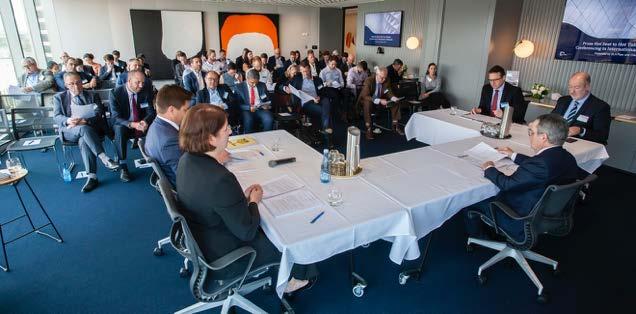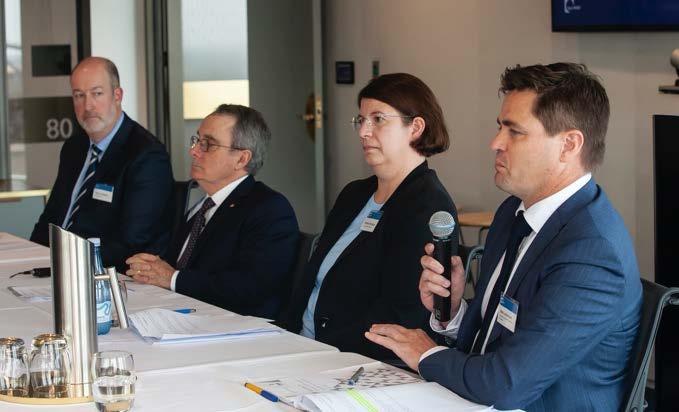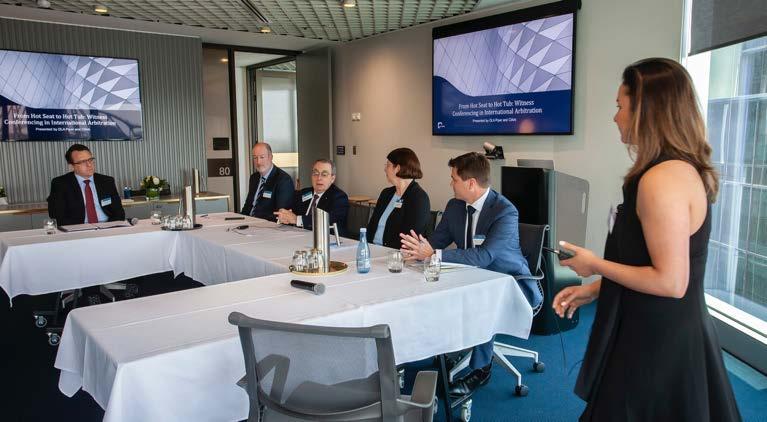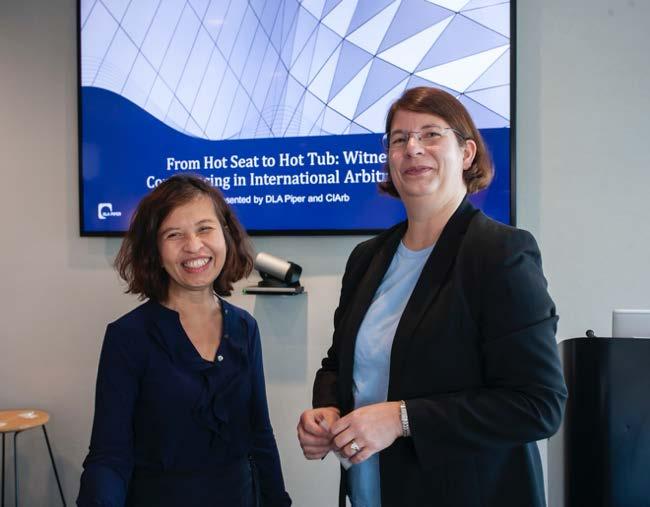
13 minute read
The Continuing Evolution of International Commercial Arbitration Paula Hodges
PAuLA HOdgEs QC2
View Profile
Advertisement
The Continuing Evolution Of International Commercial Arbitration – Is It Still Fit For Purpose?1
Introduction
The idea of resolving disputes by arbitration has a long, rich history. Even before the term "arbitration" was being used, tribunals (often consisting of elders, respected academics, or trading professionals) were tasked with resolving various kinds of disputes faced by members of their communities. Most commonly, these would be religious or personal disputes, but they could be commercial if the society was based on a system of private property ownership. These tribunals, like those of today, produced a ruling that was binding upon the parties. The binding nature of the ruling either flowed from the agreement of the parties, or as a result of social convention. Indeed, Catherine Holmes (the Chief Justice of Queensland) has explained how arbitration bears similarities to dispute resolution processes within the indigenous aboriginal culture in Australia.3
These early arbitral proceedings were what we would now consider to be ad-hoc proceedings – they were devised and developed by (and for) the parties, who chose a tribunal consisting of those best suited to resolve the issues in dispute. Over time - as the merits of arbitration become more widely recognised – there followed the development of more established systems for resolving disputes, with the disputes becoming increasingly commercial in nature.
A pivotal turning point in the evolution of international arbitration occurred with the advent of the New York Convention in 1958.4 The Convention proposed arbitration as the means to resolve international disputes in a bid to facilitate global trade, legal certainty, and ease of enforcement of awards rendered in other jurisdictions. Whilst it is unlikely that those involved in the drafting of the New York Convention truly anticipated the level of growth in world trade that has taken place since the 1960s onwards, there has been an even greater need for a legal process that can operate at a truly international level as the global economy has transcended international borders. As of today, 80% of the world's countries have signed the New York Convention, totalling 161 countries and counting.5
1. This article is based on a speech of the same title delivered on 19th November 2019 at the
CIArb Australia Annual Lecture, in Brisbane,
Australia.
2. President of the LCIA and Head of Global
Arbitration, Herbert Smith Freehills LLP. The author would like to thank Vanessa Naish, Professional Support Consultant at Herbert
Smith Freehills LLP, for her assistance in the preparation of this article. 3. Catherine Holmes, Welcome Address, CIArb
Australia Annual Lecture, Brisbane, Australia, 19th November 2019 4. Convention on the Recognition and
Enforcement of Foreign Arbitral Awards (adopted 10 June 1958, entered into force 7
June 1959) 330 UNTS 3 5. UNTC Convention on the Recognition and
Enforcement of Foreign Arbitral Awards
Alongside this flourishing regime of recognition and enforcement of arbitration agreements, jurisdictions around the world have improved and modernised their national arbitration laws - often drawing inspiration from the UNCITRAL Model Law, which emerged in 1985.6 Ad-hoc arbitration has been overtaken in many regions and sectors by institutional arbitration, with institutions springing up all over the world. Institutions can now be found from London to Hong Kong, New York to Singapore, and from Paris to Kigali. In the last 60 years, there has been a vast increase in the number of international arbitrations taking place under the auspices of arbitral institutions. In 1992 for example, the International Chamber of Commerce (ICC) had a total of 337 arbitrations; the London Court of International Arbitration (LCIA) had 21; the Stockholm Chamber of Commerce (SCC) had 63; and the Hong Kong International Arbitration Centre (HKIAC) had approximately 100.7 Fast forward 25 years or more, and the statistics paint a very different picture. In 2018 there were 840 ICC cases; 317 LCIA cases; 152 SCC cases; and 256 HKIAC cases. A number of new institutions also emerged during this period, including the Singapore International Arbitration Centre (SIAC), the International Centre for Dispute Resolution (ICDR), and the China international Economic and Trade Arbitration Commission (CIETAC), which has seen a 10 fold increase in the last 20 years from 267 cases to approximately 2962.8 Institutional arbitration, however, represents only part of the global picture. It is almost impossible to gauge the number of ad-hoc arbitrations started each year globally. LMAA arbitrations in London in 2018 alone, for example, number over 1500.9
In addition to the traditional users of arbitration (such as, the energy and natural resources, and construction and infra-structure sectors), new industry sectors have turned to arbitration. For instance, there has been a marked rise in the use of arbitration by financial institutions – a sector that has historically viewed arbitration with only tepid interest. By way of example, the number of banking and finance arbitrations administered under the LCIA rules grew significantly in 2018 - representing 29% of all cases, up from 24% in 201710 .
As of today, it is clear that arbitration serves a truly multinational and multifaceted community all over the world. The flexibility of arbitration as a means of resolving disputes is an invaluable benefit - it embraces many different procedural approaches, and leads to evolution, adaptation and innovation in ways that are not seen in national litigation systems. There are, however, occasions where there is no concrete answer to the question of "what happens next?". There is no formulaic playbook, or set timetable. This lack of clarity can present challenges and tensions. This leads me to consider, in this article, whether commercial arbitration can still be described as "fit for purpose"?
Is Commercial Arbitration still Fit For Purpose?
Given the growth in user demand described above, the commercial arbitration that is practised today appears to be a success story. Some might even go as far to as to say that the statistics speak for themselves. History, however, teaches us that it is easy to assume that stability and growth are here to stay, and yet changes in the wider world can quickly turn the tables. The UK Chancellor (and later Prime Minister) Gordon Brown, was famous for his speeches about having brought an end to the cycles of "boom and bust", just before the 2008 global financial crisis.11 The recent events in Hong Kong provide a more contemporary example of the status quo being disrupted. Sitting back on our laurels and applauding ourselves for the success of arbitration without questioning that success – questioning whether arbitration is delivering what users want – is therefore a dangerous game to play. But what do the users of arbitration really think of the process and practice of arbitration as it currently stands? The regular survey run by Queen Mary University of London (and sponsored by White & Case) provides a useful "health check".12
6. General Assembly resolution 40/72, "Model
Law on International Commercial Arbitration of the United Nations Commission on
International Trade Law, 112th plenary meeting, 11 December 1985 7. Practical Law Arbitration, 'International
Arbitration Statistics' 8. LMAA, '2018 Statistics' 9. J Clanchy, Arbitration Statistics 2018:
London bucks downward trend (2019) 10. LCIA, 'LCIA 2018 Annual Casework
Report' (2018) 11. G Brown, '"Ways and Means" Financial
Statement to House of Commons' (2007) 12. Queen Mary University of London, '2018
International Arbitration Survey: The
Evolution of international Arbitration' (2019)
What do users like about current arbitration process and practice?
Considering first what users like about the current process and practice of arbitration, 92% of the in-house counsel respondents to the survey in 2018 listed arbitration as their "preferred method of dispute resolution" for cross border disputes (either on a standalone basis, or in conjunction with other forms of ADR).13 In terms of the characteristics of international arbitration that they most valued, the top 5 were: (i) The enforceability of awards (64%): this highly valued characteristic reinforces the continued success of the New York Convention14; (ii) Avoiding specific legal systems / national courts (60%): users of international arbitration have highlighted the importance of resolving disputes through a neutral legal framework15; (iii) Flexibility (40%): recognising the ability to adapt the process and procedure of arbitration to suit the dispute and the parties16; (iv) The ability of parties to select their arbitrators (39%): ensuring that the arbitrators have the requisite legal or professional background to address the dispute; (v) Confidentiality and privacy (36%): so as to avoid washing dirty laundry in public.
What do users not like about current arbitration process and practice?
Whilst the aforementioned statistics are all very positive, they clearly do not represent the whole picture. To consider whether arbitration is fit for purpose, we also need to look at the other side of the coin – i.e. those characteristics of arbitration that users do not like. In the 2018 survey, respondents were asked to list the worst characteristics of international arbitration. In descending order, the top 5 were identified as: (i) Costs (67%): Costs were seen by respondents as the worst characteristic (by a considerable margin). It is perhaps hard to know whether this is because the arbitral process costs too much compared to other dispute resolution processes, or whether this same criticism would be applied to other forms of dispute resolution as well; (ii) Lack of effective sanctions during the arbitral process (45%): As with costs, it is hard to know the underlying reasons for this criticism and as such whether it refers to tribunals not having sufficient powers to sanction parties (or perhaps counsel), or the unwillingness of tribunals to sanction parties during the course of the arbitration (perhaps a product of due process paranoia, a desire for repeat appointments, or simple cowardice); (iii) Lack of power in relation to third parties (39%): In this regard, it is perhaps worth considering whether a lack of power in relation to third parties is just part and parcel of a process borne out of a contract between signatories, as opposed to being something that can be actively changed; (iv) Lack of Speed (34%): One has to consider whether those surveyed considered arbitration to be less fast than they would like or expect it to be, or whether they consider arbitration not to be as fast as other dispute resolution processes; (v) Lack of insight into arbitrator's efficiency (30%): This can be mitigated by the parties having regular contact with the tribunal, or specific institutional provisions to address efficiency. From reviewing this list of criticisms, it certainly seems clear that a number of improvements are needed to ensure that arbitration remains fit for purpose, and to protect arbitration from allegations that it does not meet the needs of its users. However, whilst it is clear that users would like arbitration to be quicker and cheaper, tribunals need to use their powers more robustly, and for there to be increased transparency about how arbitrators spend their time, delivering all of these improvements is not as simple as it may seem. There are a number of inherent contradictions in what parties most value on the one hand, and what they most dislike on the other. Greater transparency might undermine the desire for confidentiality, whilst prioritising speed and low cost could undermine natural justice and due process - potentially raising issues for enforceability of the final award. Further regulation of the arbitral process almost always comes at the cost of party autonomy and the availability of bespoke procedures that users strongly wish to uphold. These contradictions must be explored in more detail before any conclusion is reached as to whether arbitration is still fit for purpose.
Read more.
13. Ibid 7
14. Ibid
15. Ibid
16. Ibid
L – R: Caroline Kenny QC (President, CIArb Australia), Darren Hopkins (Partner, McGrathNicol), Prof Doug Jones AO (International Arbitrator and International Judge of the Singapore International Commercial Court), Brenda Horrigan (President, ACICA), Mark Johnston (Maxwell 42 Chambers Singapore), Gitanjali Bajaj (Partner, DLA Piper) and Liam Prescott (Partner, DLA Piper)

Out of the frying pan, into the…hot tub?
When: Where: Tuesday, 19 November 2019 DlA Piper, Brisbane
Introduction
“Out of the frying pan; into the fire” is how many expert witnesses likely feel about the prospect of moving from a cross-examination to a witness hot tub. Our esteemed panellists experienced this first hand, as we subjected them to a mock witness conference in a hypothetical international arbitration. The arbitration was presided over by the distinguished Professor Doug Jones AO, International Arbitrator and International Judge of the Singapore International Commercial Court. Counsel for the Claimant (Aus Exports Pty Ltd) was Mark Johnston, Maxwell 42 Chambers, and counsel for the Respondent (Cali Imports Inc) was Brenda Horrigan, Herbert Smith Freehills. Together in the hot tub were Darren Hopkins, McGrathNicol, and Liam Prescott, DLA Piper. Gitanjali Bajaj, DLA Piper, narrated.
summary
On Tuesday, 19 November 2019, DLA Piper hosted a seminar in conjunction with the Australian branch of the Chartered Institute of Arbitrators (CIArb) to discuss, and demonstrate in action, the new CIArb Guidelines for Witness Conferencing in International Arbitration.
The seminar began with a short Q&A with the panellists on their different experiences with expert witness examination in international arbitrations. It was interesting to hear the perspectives of counsel, arbitrator, and expert and their preferred method of witness examination. Unsurprisingly, counsel preferred having complete control over the process through counsel-led examination and, in a somewhat masochistic desire to be cross-examined, so did our resident expert. From the tribunal’s perspective, they just want to understand the issues in the simplest way possible. Following the Q&A, the panellists demonstrated three types of witness examination through a mock international arbitration: tribunal-led, counsel-led, and expert-led. The hypothetical arbitration involved the authenticity of an email allegedly sent from one of the directors of Aus Exports Pty Ltd (Aus Exports) to the director of Cali Imports, Inc (Cali Imports) attaching an updated version of contractual terms and conditions. The updated terms and conditions contained a termination for convenience clause, which Aus Exports was now relying on in an arbitration against Cali Imports. Cali Imports denied ever receiving the email, and relied on a number of discrepancies between that email and other authentic emails which it had received from Aus Exports. Our expert on the panel, Darren Hopkins (McGrathNicols), and lawyer-turned-expert-for the purposes of this mock arbitration, Liam Prescott (DLA Piper), gave evidence in relation to various issues such as email metadata and computer networks. First, they were questioned by arbitrator Professor Doug Jones in a tribunalled conference, then they were questioned by counsel Mark Johnston (Maxwell 42 Chambers) and Brenda Horrigan (Herbert Smith Freehills), and they then had the opportunity to question each other in a witness-led examination, which ended in Mr Prescott conceding (offscript) that the lawyers had actually fabricated the email.
The seminar concluded with a lively panel discussion and Q&A on the advantages and disadvantages of the three methods, and the circumstances in which they might be used. It was agreed that choosing a hot tub over crossexamination depends upon many factors, including, the subject matter, the characteristics of the expert in practice, and of course the preference of counsel and arbitrators. As to the preferred method of hot-tubbing, it was generally agreed that, in practice, different elements from each can be combined to create a more effective witness examination process.



















